
Since the Bhartiya Janata Party (BJP) came to power in Assam in 2016, several poor families in Dholpur char have been evicted thrice— the first time in November 2016, the second time in January 2021 and the third time in June 2021. Following their eviction, the displaced women folk from these families live amidst poor living conditions and are fearful of their future prospects.
Mahibul Hoque | TwoCircles.net
SIPAJHAR, ASSAM – It was a shock for 47-year-old Moijan of Dholpur village in Darrang district of Assam when her family received a notice from the district administration on June 6 informing them that their home would be demolished for encroaching into the land of a Hindu temple. The next day, her house, along with 49 other families, was ravaged onto the ground by the district police—the third time in four years.
The eviction was carried out despite the Gauhati High Court issuing an order to stay any eviction drives owing to public health crisis due to the Coronavirus pandemic.

Dholpur is a remote char (riverine islands in Assam are called char) flanked by the Brahmaputra and its many streams and Nonoi and its stream. From Sipajhar town, this is around 60 km northeast from state capital Guwahati, one has to travel around 12 kms to reach Gorukhti Higher Secondary school. From this point, after travelling another 3-4 kms towards the southwest on the dirt road along the embankment built to prevent the flooding waters of Brahmaputra from entering the villages next to the Gorukhuti-Ghorabandha PWD road, one will land on the banks of Nonoi river’s stream. From the ghat, a country-made boat fitted with an engine will ferry you to the other bank of the river. From this nearest ghat, the Dholpur bazaar is situated just around 1 km away. The Dholpur eviction site is located adjacent to this market.

The road, landscape, boat journey, and the small gorge that create a small slope on the path give a mesmerising experience during non-flooding times. The relieving and relaxing feeling ends soon when one reaches the tin-made shanties, sees remains of broken houses and listens to the agonising (mixed with anger) stories of peoples’ loss.
Moijan, who appears to be much older than her age, sees the eviction as a punishment that has taken away her sons from her and the land which she used to cultivate along with her husband. She wept as she told TwoCircles.net, “Maybe it is not in my fate that my sons would be able to bury me if I die. My husband is old and we have no land to cultivate. Both my sons had to go away to earn.”
The woman’s husband, Majibor Rahman who is 58-years-old used to cultivate around 12 bighas of land to sustain the family of nine members. Left with no work now, their two sons, 27-year-old Moinuddin Ali and 17-year-old Joinuddin Ali have gone to Coimbatore in Tamil Nadu where they work in a cushion making sponge factory.
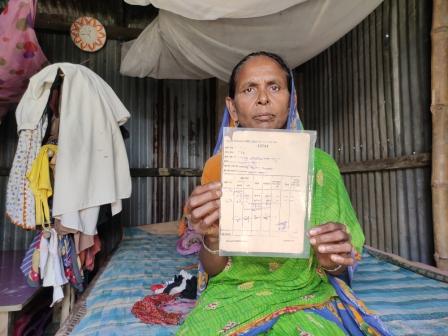
“The very thought that I may never see them if I die now is devastating. What can we do when the government keeps us evicting?” Moijan, who injured herself in a bid to protect whatever she could, said.
Apart from that, the women and the girls now have to face other problems as well. “We don’t even have toilets left to use. It is shameful to go out as men can see us going towards the fields with a water mug.”
There are no toilets for the 300-odd evicted families.
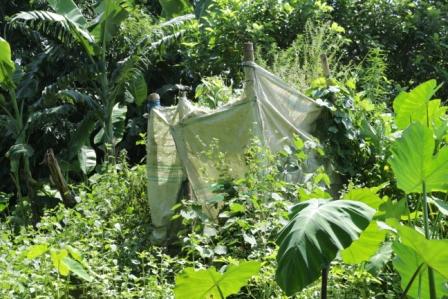
Moijan complains that there is no proper space for women to bathe. The women either go to the river or use a makeshift plastic sheet cover to take a bath.
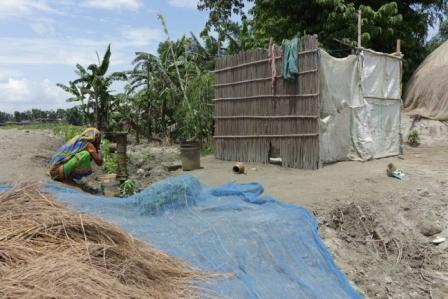
For families with more than five members, there is lack of space for sleeping. At Moijan’s house, three beds are stuffed inside a one-room house where she, her husband, daughter and daughter-in-law sleeps.
For these evicted women, privacy has no meaning.
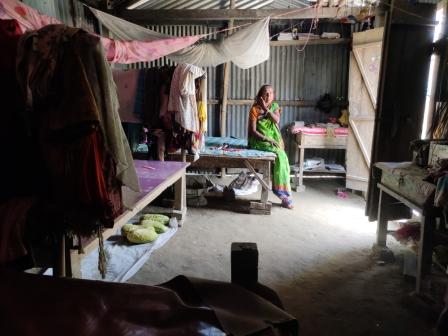
The women are also fearful of the flooding water. In char areas, residents elevate a small plot with land and built their houses on the elevated platforms along with storage structures for wire wood and cattle feeders. As eviction has forced the families to set their houses on the flat surface, floodwaters can now easily wash away the food stock and pile of firewoods.
Referring to firewood, Moijan said floodwaters could wash away whatever they have. “We make these elevated bamboo structures to store firewood. How will we cook and feed these babies if the floods wash away the firewood stock we keep here?” she asks.
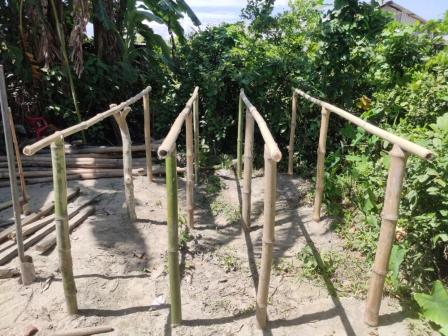
The district administration demolished 49 houses which according to the authorities had allegedly occupied the 180 Bigha land of a lord Shiva temple atop the hillock. This is contested by Moijan and other locals.
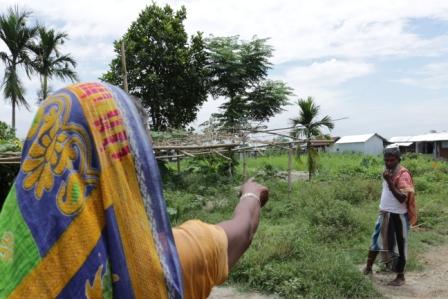
“The temple’s boundary was far away towards the eastern side from the point where the new boundary has been set. A stream of the Brahmaputra keeps eroding towards the west side, hence the government has included the farmers’ cropland inside temple boundary to make the 180-bighas of temple land,” alleged Saddam Hussain, a local from the char and a young human rights activist.
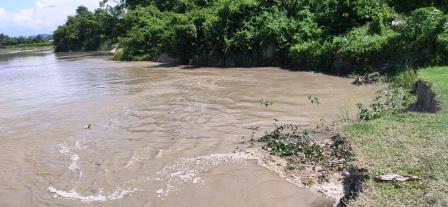
The district administration has built an “Agri bundh” (a supposedly agricultural barrier) just after the eviction. Locals said that this was built to demarcate the land of the temple that previously the affected families cultivated. Ironically, the barrier was built using a JCB and it was constructed under the Mahatma Gandhi National Rural Employment Generation Guarantee Act (MGNREGA) which prohibits the usage of JCB to carry out landfilling or digging work. The government, however, has made provisions for the usage of tractors with special permission at works done under MGNERGA.
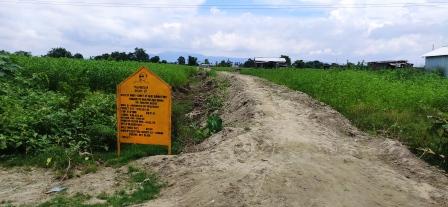
The information board put at the bundh says that the Sanowa Gram Panchayat Rs 9,80,620.00 for labour and 4603.85 labour days (which means 4603.85 days of work done at the site by labourers) for the construction work. This also reflects irregularities at the administration level.
Moreover, an independent fact-finding committee found that the families have been living in the village for more than 40 years. The report said that the families moved here after the 1983 Assam agitation which left hundreds dead. According to the report, three Hindu families also settled here, among which two moved to another place and only one Kanak Das’s family remained there and looked after the temple. During this eviction drive, Kanak Das’s widow Parbati Das was also displaced.
The fact-finding team said villagers had told them that “the temple was built in the year 1984 and Kanak Das was appointed as the caretaker of the temple”.
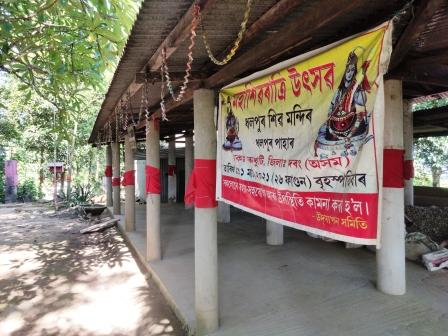
“The temple evolved over time and eventually a committee to take care of the temple was formed. After the Bhartiya Janata Party (BJP) government came to power in Assam in 2016, conflict developed between the temple authorities and the villagers. The temple authorities claimed that around 180 Bighas of agricultural land in Dhalpur belonged to the temple and hence the Muslim families residing in the 180 bighas should vacate their land,” the report alleged pointing towards the BJP’s ascent to power in 2016 in the state.
Since BJP formed the government in Assam, these families have been evicted thrice— the first time in November 2016, the second time in January 2021 and the third time in June 2021.
